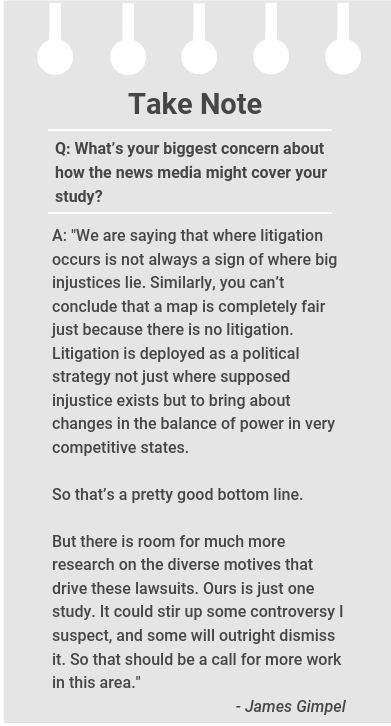Lawsuits challenging changes to voting district maps often claim officials have moved district boundaries in a way that diminishes the political power of minority groups or unfairly gives one political party an edge. But new research that examines redistricting lawsuits across six decades surmises the real reason behind them might have less to do with correcting an unjust imbalance and more to do with pushing out the party in power.
Another key finding: While the news media frequently focus on redistricting cases in the U.S. South, which has a deep history of racial discrimination and suppressing Black residents’ voting rights, these lawsuits also are common in many northern states as well as California and Washington.
Every decade, following the federal census, states redraw the boundaries of their legislative and congressional districts to adjust for shifts in population, as required by the U.S. and state constitutions. Local governments also use new population data to determine the size, shape and location of voting districts for seats on governing bodies such as county councils and school boards.
Earlier this month, the U.S. Census Bureau provided states with data from the 2020 census. As officials review district maps and debate changes, researcher James G. Gimpel points out that redistricting disputes are most prevalent in so-called “purple” states, where voters support Republicans and Democrats at similar rates.
Litigants tend to file legal challenges in places where a favorable court ruling could tip the political scale, says Gimpel, a political science professor at the University of Maryland who is the lead author of the new paper, “The Geography of Law: Understanding the Origin of State and Federal Redistricting Cases,” published in Political Research Quarterly.
“These maps are frequently imperfect and poorly drawn and you can complain about just about every map in every state,” Gimpel says. “I think in purple states, there’s a strong incentive to use the courts to get a more favorable map.”

To study redistricting lawsuits, Gimpel and his fellow University of Maryland researchers, Tristan Hightower and Patrick Wohlfarth, gathered data on cases filed in state and federal courts nationwide from 1960 to 2019. Their dataset includes 917 federal cases and 1,105 state court cases.
The researchers learned that the number of federal redistricting lawsuits grew steadily for the first three decades. The number then dropped from a peak of 41 cases filed in 1992 to 27 in 2018.
State court challenges, on the other hand, fell across the study period — by about 20 cases a year, on average.
Lawsuits claiming partisan gerrymandering — drawing voting districts in a way that gives one political party an unfair advantage — have risen over time and now match filings of race-based legal claims. Even so, far fewer disputes arise in states where one party has a clear majority of support, Gimpel and his colleagues find.
“Circumstances in which states have deeply entrenched partisan majorities in their congressional or state legislative delegations are unlikely to trigger redistricting complaints,” they write. “Even if a minority party might win a few such cases, an occasional victory is not likely to alter the balance of power in a politically lopsided state. Similarly, when a majority party is safe, map drafters in the legislature are not likely to engage in the kinds of questionable redistricting practices that might draw scrutiny. There is no need to draw unusual or distorted districts if a few seats will not change anything.”
At the state level, courts in California, Illinois, New York and New Jersey have seen the largest total number of redistricting lawsuits during this era. New York leads the group with 85 total state court cases.
The two federal judicial districts that have received the most redistricting complaints are the Middle District of Alabama, where 43 cases were filed during the study period, and the Northern District of Illinois, which received a combined 42 lawsuits. The Southern District of Mississippi ranks third with 37 cases.
Some states have avoided or mostly avoided the controversy. State courts in Utah and South Carolina had no redistricting cases filed between 1960 and 2019. Vermont and Delaware each had one. Meanwhile, there were no federal redistricting disputes filed in Idaho, Nevada, New Hampshire and Oregon.
Another trend worth noting: The rising number of federal lawsuits claiming excessive partisanship in boundary drawing is a more recent phenomenon. Those cases began to increase after 2000, researchers find.
“Federal complaints about partisan bias increase in the years that new [redistricting] plans are adopted and also increase along with the population size of the state and the percentage of African American residents,” they explain. “As the congressional delegation becomes more politically divided — an indication of statewide partisan competition — the number of partisan gerrymandering suits also rises.”
Gimpel encourages journalists to monitor local redistricting discussions and any legal disputes that arise over the coming months. He offers these three tips to help bolster news coverage:
1. Don’t assume a lack of lawsuits means voting district maps in your area are well drawn. Ask whether voters have raised concerns and why they have not pursued legal action.
“Why is litigation only in some states and in some other states, we hardly ever see it?” Gimpel asks. “It’s not because some places have better maps. These problems with the maps are pretty common — you can find something wrong with any map that you look at.”
2. Find out who’s paying for redistricting lawsuits. If it’s an organization, look into where it gets its money and whether it has backed similar lawsuits in previous years or other states.
Gimpel says redistricting lawsuits often name individual voters or groups of people as plaintiffs. However, someone else — an advocacy or partisan organization, for example — usually pays the legal bills.
“It is important to look at these groups and their approach,” he says, adding that some organizations might have considerable financial resources and political connections while others are relatively weak.
“There is no question that group strength varies,” he explains. “That matters, and reporters need to look behind it.”
3. Learn about district mapping because it’s more difficult than it appears.
Gimpel suggests journalists educate themselves about the rules and goals of drawing and redrawing voting districts. It’s a difficult task when each district within a state or region must encompass equal populations.
He also urges journalists not to rush to judgments about districts based solely on their size and shape. Some have odd shapes because of where homes are built within cities and unincorporated areas and because residents congregate near major roadways.
“It’s easy to draw districts that have strange shapes in the effort to equalize populations across districts,” Gimpel points out. “There are some very strangely-shaped districts that were not drawn that way for partisan reasons. I would hope that people would be less in a rush to judge these oddly-shaped districts as being partisan gerrymandering, because that’s not true much of the time.”
For help and insights, Gimpel recommends reaching out to political science professors who study redistricting and private-sector experts who specialize in mapping and using geographic information systems to capture and analyze geographic data. State government agencies are another resource. They employ people with mapping and GIS expertise to work on projects in areas such as redistricting, economic development and transportation.


Expert Commentary